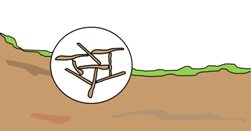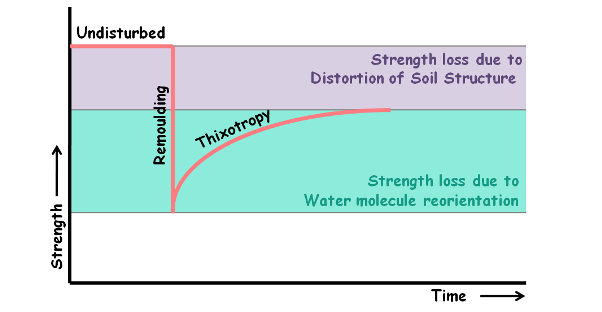 Cohesive soils have a certain particle structure in its natural state of occurrence that was developed during the original process of soil formation.
Cohesive soils have a certain particle structure in its natural state of occurrence that was developed during the original process of soil formation.
Cohesive soils are soils which particles stick to each other, which are bonded together by some force.
Soil structure means the geometrical arrangement of soil particles in a soil mass. Engineering properties and behaviour of both coarse grained and fine grained soils depend upon this soil structure.
When such soil is disturbed by loading or transportation, it is remoulded. A soil is called remoulded when it has had its natural internal structure modified or disturbed. Due to the remoulding soil’s engineering properties change considerably.

It is observed that cohesive soils, upon remoulding, lose some of their strength. The loss of the strength of a soil upon remoulding is partly due to change in the soil structure and partly due to disturbance caused to water molecules in the adsorbed layer
Some of these changes are reversible. If a remoulded soil is left alone undisturbed at the same water content for some time, it may regain part of its lost strength.
This gain of strength in the soil with the passage of time after remoulding is called Thixotropy.
This regain in strength is mainly due to gradual reorientation of molecules of water in the adsorbed water layer and due to re-establishment of chemical equilibrium.
This recovery of the strength is not hundred percent. Soil cannot achieve its original strength which was before remoulding because strength loss due the destruction of the soil structure cannot be recovered with time. Only strength loss due to disturbance of water molecules can be regained.
Let us illustrate such situation in a plot between strength of the soil and time.

Imagine that the initial horizontal curve is the initial unconfined compressive strength of the natural undisturbed soil.
Then soil is remoulded and because of that its strength decreases. The vertical drop in the curve denotes the remoulding of soil. Let us say that purple shaded part of decrease in the strength is because of distortion of the soil structure and green shaded part of strength decrease because of water molecules reorientation.
Then the soil is left alone for some time then its strength increases with time only because of reorientation of water molecules and purple shaded part of strength is lost forever.
Higher is the sensitivity of soil, which means soil loses more of its strength on remoulding, larger will be the thixotropic hardening.
We can say that because of remoulding soil becomes soft and if it is left undisturbed for some time soil regains some of its hardness.






